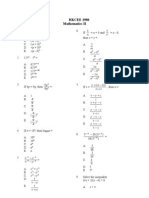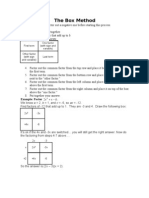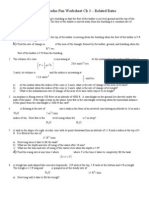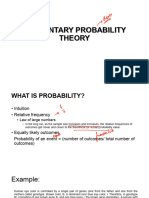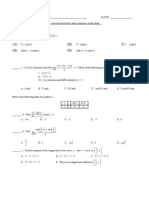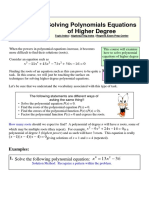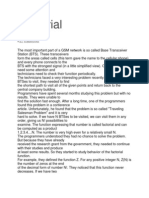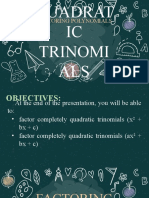0 ratings0% found this document useful (0 votes)
651 viewsFibonacci Worksheet
The document discusses Fibonacci numbers and poses several questions about properties of the numbers. It notes that every third Fibonacci number is divisible by 3 and asks the reader to verify through multiplication that the product of the first and last numbers in groups of 3 or 4 equals the square of the middle number, and that the sum of the first N terms equals the N+1 term.
Uploaded by
2820reshmaCopyright
© Attribution Non-Commercial (BY-NC)
Available Formats
Download as DOC, PDF, TXT or read online on Scribd
0 ratings0% found this document useful (0 votes)
651 viewsFibonacci Worksheet
The document discusses Fibonacci numbers and poses several questions about properties of the numbers. It notes that every third Fibonacci number is divisible by 3 and asks the reader to verify through multiplication that the product of the first and last numbers in groups of 3 or 4 equals the square of the middle number, and that the sum of the first N terms equals the N+1 term.
Uploaded by
2820reshmaCopyright
© Attribution Non-Commercial (BY-NC)
Available Formats
Download as DOC, PDF, TXT or read online on Scribd
You are on page 1/ 1
FIBONACCI NUMBERS
The first fifteen Fibonacci numbers are:
1 1 2 3 5 8 13 21 34 55 89 144 233 377 610
1. What sort of number is every third term?
2. Choose any three consecutive Fibonacci numbers.
Multiply the first by the third. Square the second.
Repeat this for other groups of three. Write what you
notice?
3. Choose any four consecutive Fibonacci numbers. Multiply
the first by the fourth. Multiply the second by the third.
Repeat for other groups of four. Write what you notice.
4. If T1 = the first term, T2 = the second term, T3 = the
third term and so on:
a) Find the sum of the first four terms. Compare the total
with T6.
b) Add the first five terms. Compare the total with T7.
c) Add the first six terms. Compare the total with T8.
d) Without adding, find the sum of the first 12 terms.
Look at questions 2,3 and 4. Can you prove them?
You might also like
- Warm Up Lesson Presentation Lesson Quiz: Holt Mcdougal Algebra 2 Holt Algebra 2 Holt Mcdougal Algebra 2No ratings yetWarm Up Lesson Presentation Lesson Quiz: Holt Mcdougal Algebra 2 Holt Algebra 2 Holt Mcdougal Algebra 227 pages
- Acc Math III Unit 2 SE Sequences Series PDFNo ratings yetAcc Math III Unit 2 SE Sequences Series PDF34 pages
- Ch-07 (Permutation and Combinations FINAL 04.01.06)No ratings yetCh-07 (Permutation and Combinations FINAL 04.01.06)26 pages
- Basics of Matrices: Prof. Dr. Shailendra BandewarNo ratings yetBasics of Matrices: Prof. Dr. Shailendra Bandewar14 pages
- Using Complex Numbers in Circuit Analysis Review of The Algebra of Complex NumbersNo ratings yetUsing Complex Numbers in Circuit Analysis Review of The Algebra of Complex Numbers9 pages
- Pythagoras' Theorem Worksheet #01, Shape & Space Revision From GCSE Maths TutorNo ratings yetPythagoras' Theorem Worksheet #01, Shape & Space Revision From GCSE Maths Tutor2 pages
- Higher Engineering Mathematics - BS GrewalNo ratings yetHigher Engineering Mathematics - BS Grewal5 pages
- SAT Test 1 Math Answers and ExplanationsNo ratings yetSAT Test 1 Math Answers and Explanations20 pages
- Factoring and Algebra - A Selection of Classic Mathematical Articles Containing Examples and Exercises on the Subject of Algebra (Mathematics Series)From EverandFactoring and Algebra - A Selection of Classic Mathematical Articles Containing Examples and Exercises on the Subject of Algebra (Mathematics Series)No ratings yet
- Application of Derivatives Tangents and Normals (Calculus) Mathematics E-Book For Public ExamsFrom EverandApplication of Derivatives Tangents and Normals (Calculus) Mathematics E-Book For Public Exams5/5 (1)
- Geometry and Locus (Geometry) Mathematics Question BankFrom EverandGeometry and Locus (Geometry) Mathematics Question BankNo ratings yet
- Practice Makes Perfect in Geometry: Three-Dimensional Figures with AnswersFrom EverandPractice Makes Perfect in Geometry: Three-Dimensional Figures with AnswersNo ratings yet

